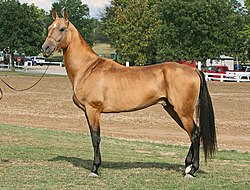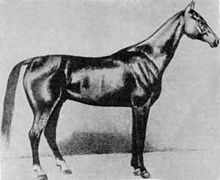Akhal-Teke
| Akhal-Teke | |
|---|---|

|
|
| Important data | |
| Origin: | Turkmenistan |
| Main breeding area: | Turkmenistan, Kazakhstan , Kyrgyzstan , Uzbekistan |
| Distribution: | |
| Stick measure : | 147-168 cm |
| Colors : | Foxes, browns, black horses, gray horses, falcons, Isabelles |
| Main application area: | Horse racing and endurance riding |
The Akhal-Teke horse ( Turkmen Ahal-teke aty , Russian Ахалтекинская лошадь ; also Akhal-Teke horse ) is one of the oldest horse breeds in the world. Due to its isolation on desert oases and the arid desert climate geared towards extreme hardness, it is particularly suitable for difficult distance stretches .
The breed bears its name because of the area of origin, the Achal-Teke oasis group , which stretches between the northern edge of the Kopet-Dag Mountains and the Karakum desert in a narrow strip over 100 kilometers long from the city of Annau in the east via the Turkmen capital Ashgabat to Baherden extends to the west. Teke was the name of a Turkmen tribe living in this area . The name Achal has now passed to the central province of the country Ahal welaýaty , which, however, also includes mountain and desert areas as well as the Atek oasis group further east around the city of Kaka .
Background information on horse evaluation and breeding can be found under: Exterior , interior and horse breeding .
Exterior
The exterior of the Akhal-Teke is relatively inconsistent and yet fundamentally different from all other horse breeds.
The height of the Akhal-Teke is between 1.50 meters and 1.60 meters. The physique is rather unusual for a thoroughbred horse because it has some peculiarities that are usually rated as faults. These include the often cow-hocked hind legs, the narrow position of the rear and front legs, the steeply erect neck and the building proportions with a long back and the weak loins.
He has a high carried head with a straight profile, a long, narrow, rather high set neck, a medium-long, sometimes steep shoulder and a long straight back. It is long-legged with no droppings, has small, hard hooves and a silky-looking mane with a rather sparse tail. The withers are pronounced, the croup is slightly sloping, the hindquarters slightly angled - which is not desirable in other breeds. The ears are longer and wider apart than other horse breeds and are slightly sickle-shaped. The eyes often appear almond-shaped. This impression is reinforced because many horses have a black border around the eyes.
The most common colors of the fine, thin fur in this breed are foxes, browns, gray and black horses, as well as their lightening due to the cream gene . The fur often has a metallic sheen, so that Isabelles, Buckskins, Cremellos and Perlinos in particular have a golden shine. The often gold shimmering color earned them the name heaven horses in China , which is why the Chinese emperors even waged war with Bactria to get possession of the horses.
The movements are expansive and extremely elastic, the galloping ability is particularly pronounced. There is a predisposition to passport and tölt .
interior
Extremely sure-footed, agile and with strong nerves. Many of them turn out to be true all-rounders in a wide variety of equestrian sports and are not only durable, but also extremely willing to perform well into old age. Quite a few Olympic champions were Akhal-Teke. The Akhal-Teke is mainly used in Turkmenistan for horse racing . Outside of its breeding areas, it is known for its extreme hardness on long distances in difficult conditions. Akhal-Teke horses are among the toughest, most resilient horses in the world. With them it was possible in the past to cover long distances in a short time. Due to his high degree of adaptation to life in the desert, even crossing large desert areas does not pose unsolvable tasks for him.
Breeding history
The Akhal-Teke is a horse breed that is perfectly adapted to the desert and whose origins lie in the dark. Their breeding area extends over several countries from Kazakhstan to Turkmenistan to Afghanistan . This very old horse breed has been bred in this form in Turkmenistan for almost 3000 years. Even before the Christian era, the Akhal-Teke was known and coveted as far as China. Wars and raids decimated the breed, which was then refreshed by Timur Lenk (1336–1405) with Arab mares.
Akhal-Teke were used for the refinement of European breeds, especially Turcmainatti is often represented in the pedigrees. The Russian-born stallion came to the Friedrich-Wilhelm-Gestüt in Neustadt an der Dosse in 1791 and delivered sixteen stallions there with Trakehner mares for the main Trakehnen stud and the East Prussian state studs. There he was listed as a thoroughbred Arab. However, there was no evidence of his parentage, it is likely that it was an Akhal-Teke. Also at Byerley Turk , one of the three founders of the English thoroughbred , it is presumed that he is Turkmen origin.
The stud book of this breed was opened in 1917 and is kept in Russia , although since the collapse of the Soviet Union Turkmenistan has been claiming the right to keep the stud book. English thoroughbreds were crossed from 1920 onwards. However, this did not prove to be an advantage and so it was decided by the breeding management that all crossbreed products born after 1936 are no longer considered pure-bred. The crossbreeding that took place before this time remained in the studbook (for example 044 Tillja Kusch, grandson of the English thoroughbred stallion Burlak, or 831 Mach, both granddaughter of the English thoroughbred Blondelli and great-great-granddaughter of the English thoroughbred Junak).
Since all studbook documents are in Moscow, only those Akhal-Teke horses whose ancestors are recorded in the VII studbook are considered pure-bred. The Akhal-Teke is the heraldic animal of Turkmenistan and is honored there every year in April on the Day of the Turkmen Horse with festivities. Yanardag , an Akhal-Teke World Champion born in 1991, is shown in the coat of arms .
The Akhal-Teke is kept in free-range herds in its country of origin, which are called tabun . The herds are looked after by mounted shepherds on the vast steppe area.
Hereditary diseases
Two hereditary diseases are currently of interest in Akhal-Teke:
- The Naked Foal Syndrome is presumably an autosomal inherited, lethal and recessive gene, but the exact inheritance has not yet been scientifically proven. The genetic defect causes a complete lack of fur, including long hair such as mane and tail, from birth. In some cases the incisors have not yet erupted or molars grow in an abnormal direction from what are otherwise normal appearing jaws. Other symptoms include persistent and recurring diarrhea, frequent indigestion, and laminitis-like, treatment-resistant rotation of the coffin bone . Due to the lack of any protection, flaky, dry and inflamed skin, as well as severe sunburn in summer and frequent lung infections in winter, are secondary symptoms. NFS is always fatal, with most foals dying within weeks of birth, although some horses can live up to two years. The early deaths are mostly caused by digestive problems, while the older animals have to be euthanized because of the severe pain caused by laminitis . The disease has some similarities with Epitheliogenesis Imperfecta (JEB or EI), which occurs, for example, in Belgian draft horses or American Saddlebreds . The first cases of NFS were recorded within the Akhal-Teke breed as early as 1938. Despite the low population, naked foals have already been born in every country where the breed is found, including Germany and the United States. So far around 35 carriers of the defect have been identified, for example 943 Arslan, 736 Keymir, 2001 Mariula or 1054 Gilkuyruk. The likely number of previously unknown cases is much higher, however, as several Russian and Turkmen breeders admitted that many NFS foals are only statistically reported as stillborn or aborted, if at all.
- Hereditary cryptorchidism is very common within this breed. There are many cases in which affected stallions can be traced in a direct line over several generations. The influential stock stallion 2a Boinou was a Russian breed expert after a cryptorchid. Other confirmed cryptorchids were for example 779 Peren, 1248 Orlan, 971 Khalif and Garajusup. 1069 Kortik fathered three sons suffering from bilateral and unilateral singularity . In contrast to most European and many North American breeding organizations, both Russia and Turkmenistan allow breeding with cryptorchids. Cryptorchidism is widely seen in veterinary medicine as a cause of health and character problems, such as testicular cancer or malignancy. Affected horses cause significantly increased costs when they are castrated.
Individual evidence
- ↑ Dr. Bruno Schmidt: Heredity studies in the Royal Main Stud Trakehnen , Hanover 1913
- ↑ Dr. Dr. hc Johannes Erich Flade : The Achal Teke Horse ( Memento from April 1, 2010 in the Internet Archive ) (PDF; 1.2 MB)
- ^ Studbook III of the Akhal-Teke breed, by MI Belonogow, published in Tashkent in 1941
- ^ "The Stavropol Sphinx", Akhal Teke Inform 2006
- ↑ eg "10th Stud Book, Volume II, Page 160": 2860 Mriya, naked foal (dead), born. 2000, from 1201 Kavkas (published 2005 by VNIIK, Riasan)
- ^ "Hairless Foal Photos" ( Memento June 7, 2012 in the Internet Archive ), accessed on July 11, 2009
- ↑ http://www.maakcenter.org/ENG/Moscow2003/showres_p.html , accessed on July 11, 2009, quote: Stallion Garaiusup, black, "Young World Champion 2002", was granted a Special Prize for the most expressed breed type, but the jury had to move him to the 8 place because of unilateral cryptorchidism and spavin.
See also
Web links
- Website of the Akhal Teke Breeders and Friends e. V. (Germany)
- Website of the Friends of Akhal-Teke Association (Switzerland)
- Dr. Dr. hc Johannes Erich Flade: The Achal -Teke - Horse (PDF; 1.2 MB)

